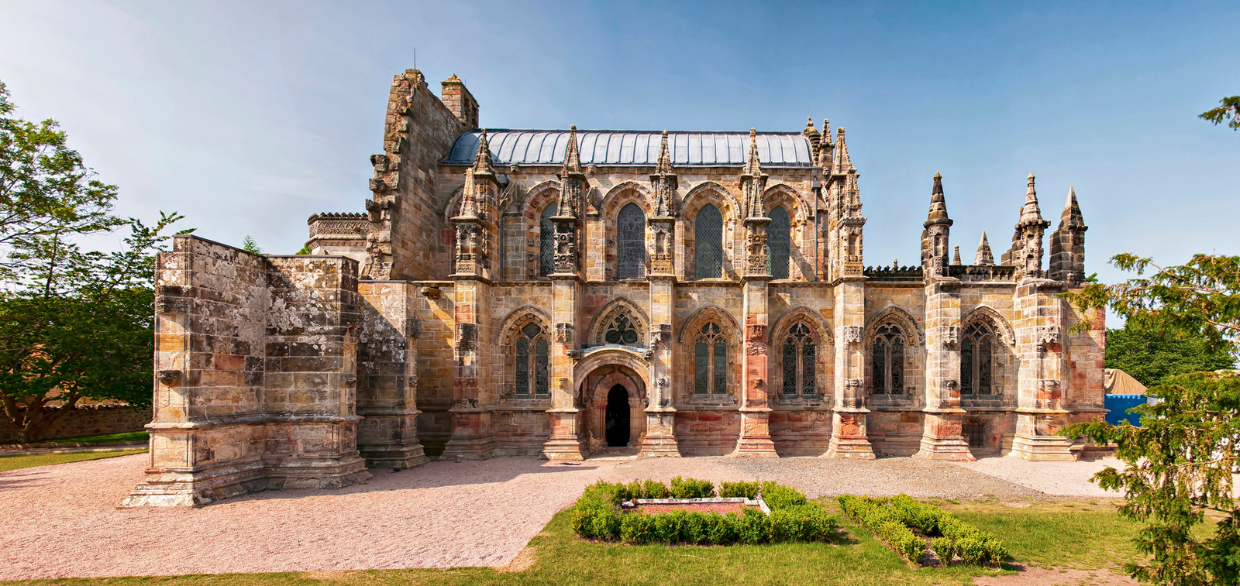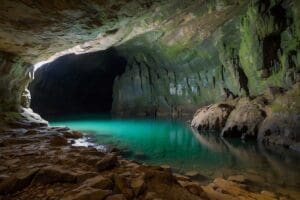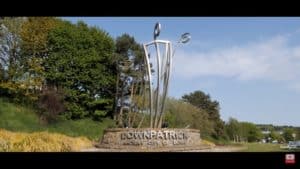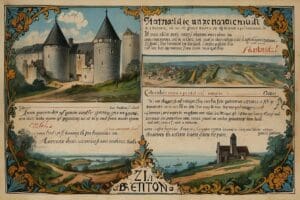The Da Vinci Code’s Europe: A Masterpiece From Paris to Edinburgh

Updated On: April 23, 2024 by Maha Yassin
Embarking on the trail of The Da Vinci Code is like peeling back the layers of history to uncover the secrets beneath some of Europe’s most famous landmarks. The novel, which intertwines fact with fiction, has inspired countless travellers to follow the paths of its characters across the continent. From the Louvre in Paris, housing the enigmatic Mona Lisa, to the ancient streets of Edinburgh, where the mysteries of Rosslyn Chapel await, the journey is as much about discovering the locations as it is about delving into the story’s thrilling narrative.
The essence of The Da Vinci Code journey is not solely bound to the intrigue of unravelling a puzzle. It’s also about appreciating the rich tapestry of European history and culture. As we traverse the bustling streets of London and absorb the architectural wonders and whispers of Lincoln’s historical connections, we encounter a fusion of the old and the new. Even as we reach the Italian landscapes that influenced Da Vinci’s masterpieces, the trail leads us to a deeper understanding of symbolism and the Knights Templar’s historical underpinnings.
Unravelling The Mystery Of The Da Vinci Code
In The Da Vinci Code, Dan Brown weaves a captivating narrative that entices us to explore the secrets of Europe through the eyes of Robert Langdon, a symbologist. The book hinges on the quest for the Holy Grail, which is suggested to be not a physical chalice but a metaphor for Mary Magdalene, who is posited to carry the bloodline of Jesus Christ.
As we traverse Paris to Edinburgh, we’re enveloped in a tapestry of symbols and riddles embedded in historical landmarks. One of the central motifs is the role of the Knights Templar, an order whose myths and legends add layers of complexity to Langdon’s journey.
Although a work of fiction, the novel prompts us to question historical narratives and the integrity of long-held beliefs. The line between what is fact and what is Brown’s fictionalisation becomes a curious point of intrigue.
We embrace our role as guides through Dan Brown’s Secret Europe, understanding that The Da Vinci Code is more than a novel—it catalyses cultural and historical curiosity. The book adeptly uses the allure of the unknown to encourage a deeper appreciation of our past while providing thrilling entertainment. This literary adventure invites us to look beyond the written word and forge our path to knowledge and truth.
Journey Through Paris: The Start Of The Trail
Embarking on a trail weaving through the enigmas of The Da Vinci Code takes us first through the heart of Paris, exploring the novel’s iconic locations that have intrigued readers globally.
The Louvre’s Enigmatic Artworks
Our adventure begins at the Louvre Museum, a historic tower whose very walls seem to whisper of age-old secrets. Inside, we find ourselves face to face with the Mona Lisa, Leonardo da Vinci’s most famous painting that holds the gaze—and countless theories—of the world. Venturing beyond, we unearth the museum’s interior, a tapestry of artistic masterpieces, some of which play a pivotal role in unravelling the novel’s intricate plot.
Mysteries At The Palais Royal
Only a stone’s throw away from the Louvre, the Palais Royal awaits with its stately garden maze and striking exteriors, a perfect backdrop for whispered conspiracies. We stroll along its corridors, imagining the clandestine meetings that might have occurred in these elegant spaces, pondering the mysteries that entwine the palatial grounds with the lore of The Da Vinci Code.
Ritz Paris: A Luxurious Narrative

Concluding the Parisian chapter of our trail is the prestigious Hotel Ritz Paris. It’s more than a luxurious stop; the hotel is a historical landmark, offering plush surrounds where one can almost hear the subtle rustle of intrigue through its opulent halls. Pausing here allows us to appreciate how luxury and narrative are expertly interwoven in Dan Brown’s Paris.
Witness the beguiling journey unfold as we trace the footsteps of The Da Vinci Code through Paris, from the revered Louvre Museum to the iconic Palais Royal and the sumptuous Hotel Ritz Paris.
Exploring The Heart Of London
London, a city steeped in history and secrets, offers an immersive experience for The Da Vinci Code fans. We journey through some of its most enigmatic sites closely tied to the novel and its film adaptation, tracing the steps of the characters and uncovering the connections to the Knights Templar and historic landmarks dotted throughout the city.
Westminster Abbey’s Secrets
Westminster Abbey is at the core of our exploration and pivotal to The Da Vinci Code story. Established in the 10th century, this architectural marvel has been a coronation church since 1066. Within its Gothic walls, visitors may find the tomb of Sir Isaac Newton, mentioned in the novel, and observe the Poets’ Corner, where some of the most notable literary figures are celebrated.
Temple Church And The Templars
A short walk from the grandeur of Fleet Street, Temple Church stands as a testament to the mysterious Knights Templar. Founded in the late 12th century, this church was modelled after the circular Church of the Holy Sepulchre in Jerusalem. The effigies of knights in Temple Church bring to life the Order’s storied past, capturing the imagination of those retracing the Templar’s influence through London’s history, as Dan Brown’s characters do in the narrative.
Historic London Landmarks
As we traverse London’s streets, iconic landmarks silently witness centuries of intrigue. From Trafalgar Square, a frequent filming location, to the enigmatic ambience of King’s College, often associated with the Holy Grail legend, these sites tell a tale secondary only to the city’s myths. Each step on our route unveils layers of stories, merging fact and fiction and leaving us to discern where the line between the two blurs.
Edinburgh’s Enigma: Rosslyn Chapel And Beyond
Nestled in the rugged Scottish landscapes, Rosslyn Chapel remains a gem steeped in the mystery of Edinburgh’s historical lore, while the Royal Mile paves a path through the city’s royal and rebellious past.
Rosslyn Chapel’s Templar Ties

Rosslyn Chapel is a testament to Scotland’s enigmatic history, its walls and carvings hinting at connections to the famed Knights Templar. Located just a few miles from Edinburgh, the chapel gained worldwide fame for its intricate stone carvings and as part of the narrative in The Da Vinci Code. It is said to be a trove of secrets, with links to the Holy Grail and the storied Ark of the Covenant. Discover the chapel’s mysteries, as they are not only limited to legends but are also rooted in historical intrigue made famous by Ron Howard’s adaptation.
Edinburgh’s Historic Royal Mile
Our story continues along Edinburgh’s Royal Mile, a stretch that leads us through the heart of Scotland’s capital and its vibrant history. As we stroll this iconic avenue, we walk the same cobblestones that kings, queens, and ordinary folk have tread for centuries. History is etched into every corner, from the commanding presence of Edinburgh Castle, down through the maze of closes and courts, to the grandeur of the Palace of Holyroodhouse. The Royal Mile isn’t just the physical artery of Edinburgh; it’s the narrative thread that weaves the city’s grand tapestry, echoing tales of power, triumph, and intrigue, all found in the shadow of the great abbey at its end.
The English Connection: Lincoln And Beyond
Unravelling the threads of history and architecture in England, we discover connections to the narrative of The Da Vinci Code. Lincoln and its surrounding castles offer a unique glimpse into the storied past that has captured the imagination of many.
The Secretive Lincoln Cathedral
The majestic Lincoln Cathedral is a testament to England’s rich architectural heritage. Once the world’s tallest building, this imposing Gothic cathedral holds centuries of history within its walls. It’s no wonder that the Lincoln Cathedral has often been shrouded in tales of mystery and intrigue, embracing the aura of secrets reminiscent of the thrilling quests in The Da Vinci Code.
England’s Da Vinci Code Inspired Castles
Remarkably, The Da Vinci Code’s allure extends to England’s stately castles. Burghley House, with its majestic Elizabethan architecture, has enraptured visitors with its historic charm and intricate stonework, while Belvoir Castle, perched regally atop its hill, epitomises the quintessential English castle. These castles offer a journey into history and architecture and a foray into the narrative landscapes associated with the charisma of The Da Vinci Code.
Unveiling The Italian Influence
As we explore The Da Vinci Code’s secret Europe, the Italian narrative chapters cast long shadows over the story’s tapestry. In the land of Leonardo da Vinci himself, Italy’s influence permeates through the cryptic avenues of the book, mainly reflected in the art, architecture, and historical enigmas.
Following Da Vinci’s Footsteps In Italy
On a quest that leads us across the storied Italian landscapes, we traverse cities deeply intertwined with Leonardo’s legacy and mysteries that echo the narrative of The Da Vinci Code.
Rome, where antiquity and secrets are etched into its very cobblestones, is a pivotal stage for unravelling the novel’s enigma. Here, a murder within the hallowed walls of the Vatican sombrely kicks off a trail of covert symbols and cyphers. Winding along the River Tiber, the story navigates Rome’s juxtaposition of the sacred and the profane.
Venturing north, we reach the ambience of Milan, where the iconic painting of The Last Supper resides. Each brushstroke of this masterpiece in the Santa Maria delle Grazie hints at the untold stories Leonardo infused into his art, perhaps concealing more than just a biblical scene. It’s a symbolic stop for enthusiasts seeking to touch the pages of history that informed Dan Brown’s thrilling narrative.
The Art Of Symbolism And Its Interpretations
In exploring the secret corners of Europe as illuminated by The Da Vinci Code, we find that understanding historical symbols is crucial, especially those embedded in art and architecture.
Leonardo’s Legacy And Symbolism
Leonardo da Vinci stands as a towering figure in the art world, not only for his masterpieces but also for the intricate symbols they contain. His works, layered with complexity, often hold deeper meanings that have sparked endless interpretations. In the context of The Da Vinci Code, his painting The Last Supper exemplifies this, where symbolism is proposed to play a key role in the narrative; it serves as a map, with characters interpreting certain elements as hidden signs.
At Saint-Sulpice Church, the line known as the Rose Line, which some people erroneously believed to be the prime meridian before the Paris Meridian was accepted, is marked by a brass strip. This church is also home to a gnomon, an element in The Da Vinci Code suggested to play a part in a puzzle involving the secret of the Priory of Sion. While this fictional account has no basis in reality, the prominence of Saint-Sulpice in the story brings to life the interplay between location and symbolism.
The depiction of the Virgin in Leonardo’s works also weaves into the symbology, often interpreted in the novel in a manner that diverges from traditional Church teachings. This presents an intriguing blend of fact and fiction, encouraging us to question what we take for granted about these renowned artworks.
Symbols like a meridian, often found in churches, are historically used to indicate the direction of prayer but are reinterpreted in the novel to suggest hidden paths to knowledge and power. The gnomon of Saint-Sulpice, a simple sundial line, becomes a significant element in a web of symbolic interpretations across Europe.
Leonardo’s legacy is thus not just in his art but also in the symbols he allegedly conceals within, which The Da Vinci Code brings to the foreground, stirring our curiosity and inviting us to look beyond the canvas.
The Historical Underpinnings Of The Knights Templar
The Knights Templar emerged in the early 12th century, initially tasked with protecting pilgrims journeying to the Holy Land. Hugues de Payens and his comrades founded the Order around 1118, officially recognised by the Catholic Church. They are often associated with the iconic knights in shining armour, symbolising nobility and chivalry.
In their early years, the Templars’ influence grew rapidly. They established a robust financial network and built formidable fortresses throughout the medieval world. Their rise to power was supported by the Church and European monarchies keen on the success of the Crusades.
The Templars’ history is embroiled in legend and myth, partly due to their close association with religious symbols such as the cross patée, which adorned their white mantles. Rumours swirled about their guardianship of sacred relics, possibly including artefacts linked to Jesus Christ or items like the Holy Grail.
Despite their pious beginnings, the Templars also engaged in military actions, becoming skilled fighters in the Crusades. They were driven by a strict code of conduct that blended the life of a monk with that of a soldier, earning them the title Poor Fellow-Soldiers of Christ.
The Templars’ decline began in the early 14th century when King Philip IV of France, indebted to the Order and coveted their wealth, orchestrated their downfall. On Friday, 13 October 1307—a date some claim has led to the superstition surrounding Friday the 13th—many Templars were arrested and later executed over charges of heresy and other crimes.
The once-vast Templar network has since inspired countless stories and theories, not least in works like The Da Vinci Code, where the Order’s enduring legacy captivates imaginations with whispers of buried secrets and lost wisdom.
We can relish that the tale of the Knights Templar is a rich tapestry woven through our history, a blend of fact and fiction that continues to fascinate and inspire exploration into the mysteries of our past.
Da Vinci Code Tourism: A Traveler’s Guide

Embark on a journey through the heart of Europe, tracing the mysterious path laid down by Dan Brown’s The Da Vinci Code. Our guide will lead you through the historic streets of Paris to the chambers of Edinburgh’s storied landmarks, crafting a travel experience that weaves together the tapestry of history with the thrill of discovery.
Planning Your Da Vinci Code Itinerary
Creating your Da Vinci Code journey involves pinpointing the key locations featured in the book and film. Utilise our curated list to schedule visits to landmarks like the Louvre in Paris, where the story begins, or Westminster Abbey in London. Convenience is essential, and we recommend booking Eurostar tickets for swift travel between cities. While in London, don’t miss the Temple Church, and then go north to Rosslyn Chapel near Edinburgh. Tapping into local insights can enrich your experience; consider engaging a local guide to gain a deeper understanding of the history and secrets of each site.
- Paris: Louvre Museum
- Saint-Sulpice Church
- London: Westminster Abbey
- Temple Church
- Edinburgh: Rosslyn Chapel
Accommodations And Local Insights
Choosing suitable accommodation is pivotal for immersing yourselves in The Da Vinci Code atmosphere. We recommend establishments that resonate with the story’s backdrop, enhancing your adventure. Friends travelling together might find boutique hotels or local B&Bs more enjoyable, offering comfort and local flavour. Gather insights from local hosts or concierge services to uncover hidden gems and lesser-known facts that add a layer to your Da Vinci Code exploration.
Travel And Cancellation Policies
Given that unforeseen circumstances can arise, we underline the importance of understanding travel and cancellation policies. When arranging travel and lodgings, ensure clarity on refundability and the terms of alterations. Securing flexible options safeguards your trip and investment, particularly within the scope of bespoke travel packages or speciality tours. Always keep travel insurance in mind as an extra layer of protection, allowing you to venture through the enigmatic footsteps of Robert Langdon with greater peace of mind.
Controversies And The Cultural Impact Of The Da Vinci Code

In the literary world, few novels have sparked as much debate as Dan Brown’s The Da Vinci Code. Central to the novel’s controversy is the speculative assertion that Jesus Christ married Mary Magdalene and that a bloodline extends from this union. These provocative suggestions caused an uproar, leading to widespread discourse on the author’s creative liberty versus historical accuracy.
The depiction of Freemasonry and other secret societies in the quest for the Holy Grail also drew criticism for allegedly distorting established beliefs and historical facts. Consequently, Dan Brown’s work was lauded for its page-turning intrigue and criticised for its contentious content.
The Da Vinci Code extends beyond the book’s pages, entwined with real-world locations and iconic landmarks. Places like the Louvre Museum, Westminster Abbey, and the Ritz Paris became pilgrimage sites for fans eager to traverse the path of the novel’s protagonist, Robert Langdon.
The story’s reach was magnified when transformed into a Hollywood blockbuster, capturing imaginations on a global scale and cementing the novel’s scenes in visual memory. The striking visuals of movie locations throughout Paris and beyond augmented the book’s influence, propelling these historic sites to newfound prominence.
In essence, The Da Vinci Code weaves fiction and fact, challenging traditional narratives and inspiring investigation into Europe’s religious history and the legacy of secret societies—its legacy enduring in the endless debates it spawned and the heightened interest in the mystery-riddled corners of Europe.
The Da Vinci Code In Popular Culture
Film Adaptation: We cannot discuss The Da Vinci Code in popular culture without highlighting the 2006 blockbuster film, where Tom Hanks portrayed the protagonist, Robert Langdon. The adaptation reinforced the novel’s status as a global phenomenon, captivating audiences with riveting performances and a fast-paced narrative.
Cultural Impact: Beyond the silver screen, the story’s blend of fact, fiction, and conspiracy theories sparked widespread discussions and analyses. Due to its gripping plot and historical references, The Da Vinci Code engaged our imaginations and prompted us to reconsider history and art.
Hollywood & Beyond: Hollywood’s recognition of the novel’s allure, reinforced by a stellar cast, bridged the gap between the book’s readers and a wider movie-going audience. By choosing authentic movie locations, such as the Louvre in Paris and Westminster Abbey in London, the film lent credibility and immersion to its portrayal of Dan Brown’s narrative.
Influence on Tourism: The tourism boom at key locations depicted in the novel and film was perhaps less expected. Curious minds and fans flocked to places linked to the book, eager to follow in Langdon’s footsteps. The tale’s intricate weaving of lore and mystery made sites like the Rosslyn Chapel near Edinburgh more than just architectural marvels; they became emblems of the search for truth within the legend.
In exploring how The Da Vinci Code has embedded itself into popular culture, we confirm its role as a work of fiction and a cultural artefact that continues to influence travel, art appreciation, and the quest for historical mysteries.






